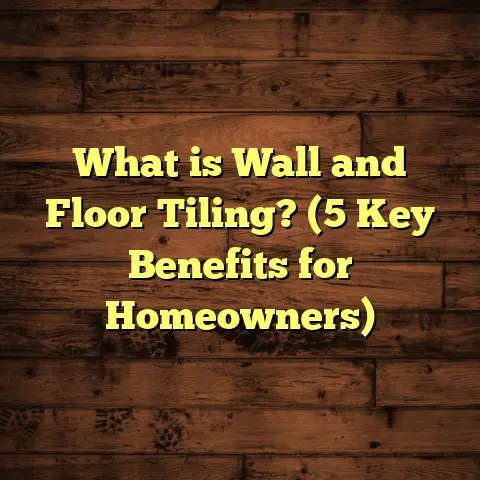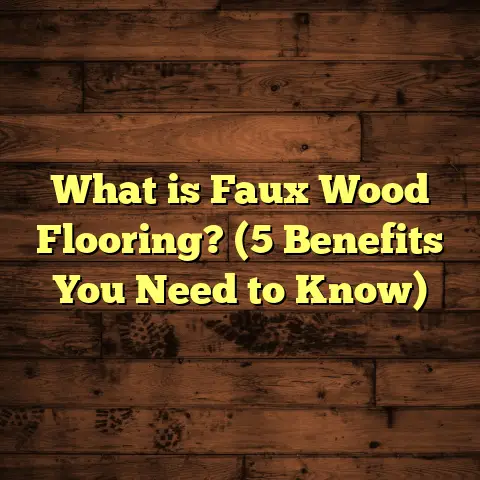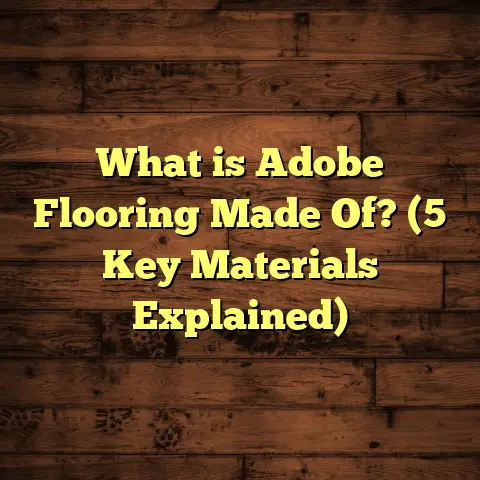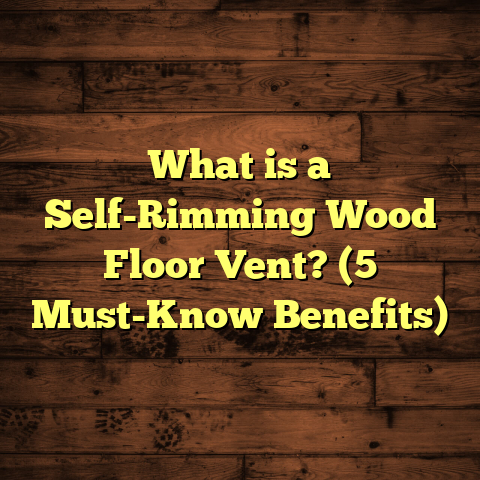What is Floor Moulding Called? (7 Types You Need to Know!)
When I think about family and home, what comes to mind are those little moments that make life cozy and meaningful. The sound of kids running through the hall, the smell of fresh coffee in the morning, and even the feel of smooth floors beneath your feet. Over the years working as a flooring contractor, I’ve realized that some details—like floor moulding—play a bigger role in creating that homey atmosphere than most people realize. Have you ever stopped to wonder what that strip running along the bottom of your walls is called? Or why there seem to be so many different kinds? I’m here to share everything I’ve learned about floor mouldings—their names, types, how they work, and why they matter a lot more than you might think.
What Is Floor Moulding?
Let’s start with the basics. What exactly is floor moulding?
Floor moulding is a type of trim or finishing material installed where your walls meet the floors. It’s a narrow strip made from wood, MDF, vinyl, or other materials that covers the joint between flooring and wall. This little strip serves several purposes: it hides gaps or expansion spaces left during flooring installation, protects walls from scuffs and damage, and adds an aesthetic finish to your rooms.
Imagine you’ve just laid down brand-new hardwood floors. There’s often a small gap left around the edges to allow for natural expansion and contraction of wood due to humidity changes. Without floor moulding, this gap would be visible and could collect dirt or debris. The moulding covers this gap neatly. It’s like putting a frame around a picture—it completes the look.
But floor moulding isn’t just decorative. Over my years installing floors in various homes—from cozy family houses to larger estates—I’ve seen how it protects walls from vacuum cleaners, furniture bumps, and even little kicks from energetic kids or pets. Without moulding, your walls would show wear much faster.
So, putting it simply: floor moulding is the finishing trim at the base of your walls that hides gaps, protects surfaces, and brings style to your floors.
Why Knowing the Types of Floor Moulding Matters
You might be thinking: “Isn’t all floor moulding basically the same?” Actually, there are several different types—each with its own design and function. Choosing the right one can affect both the look and durability of your space.
When I first started working with clients, many would ask for “just baseboards” without knowing there were other options better suited for their floors or style. Some types are better for hardwood floors; others work great with tile or carpet. Some are simple and subtle; others add a decorative flair.
In my experience, understanding these differences helps homeowners make smarter choices that save money in the long run and result in a finished product they love.
To give you a practical overview, here are the seven main types of floor moulding you should know:
1. Baseboard Moulding
Baseboard moulding is hands down the most common type of floor moulding. If you look around your home right now, it’s very likely what you see running along the bottom of your walls is a baseboard.
What Does It Look Like?
Baseboards are usually flat or slightly contoured boards about 3 to 8 inches tall—sometimes taller in more formal or older homes. They cover the joint between wall and floor and protect walls from kicks, scuffs, or furniture bumps.
Why Baseboards Are Popular
I’ve installed baseboards in hundreds of homes because they’re functional and versatile. They come in countless styles—from simple modern squared edges to elaborate Victorian profiles—and can be painted or stained to match any décor.
One project that sticks out was a family home where we swapped out old, chipped baseboards for new ones with a classic colonial profile. The difference was dramatic: the house instantly felt more polished and cared for.
Cost Insights
Baseboards are generally affordable but prices vary based on material and style. According to HomeAdvisor’s data:
- Material cost: $0.50 to $3 per linear foot
- Installation cost: $1 to $3 per linear foot
So overall, expect $1.50-$6 per linear foot if hiring someone.
DIY installation can save money but requires careful measuring and cutting.
2. Shoe Moulding
Shoe moulding is one of those little details that can make a huge difference if you have hardwood or laminate floors.
What Is Shoe Moulding?
It’s a thin strip of moulding—usually about 1/2 inch tall—with a rounded or quarter-circle profile that fits neatly between the baseboard and the floor.
Why Use Shoe Moulding?
When I installed hardwood floors in a client’s basement with an uneven subfloor, shoe moulding was essential. It covered small gaps between baseboard and floor caused by unevenness or slight height differences.
Shoe moulding helps create a smooth visual line along the bottom of your walls while allowing your floor some room to expand.
Real-world Example
A customer once told me their floors looked “unfinished” before we added shoe moulding—they couldn’t figure out why until we put it in place. It was like adding a tiny frame that made everything look complete.
3. Quarter Round Moulding
Quarter round is similar to shoe moulding but slightly larger—a quarter of a round cylinder shape.
How Is It Different From Shoe Moulding?
Quarter round usually has a bigger profile than shoe moulding but serves a similar purpose: covering gaps between floors and baseboards.
When To Use Quarter Round
I prefer quarter round when working with hardwood floors that have larger expansion gaps or when clients want a more noticeable trim that adds some weight to the baseboard area.
For example, in my own home renovation, I chose quarter round over shoe moulding because it felt sturdier underfoot and balanced well with the tall baseboards I installed.
4. Cove Moulding
Cove moulding has an inward curved shape (concave), creating an elegant shadow and smooth transition between surfaces.
Where Is Cove Moulding Used?
While less common as floor trim compared to baseboards or shoe mouldings, cove moulding is beautiful when installed at wall-floor junctions or even at ceilings.
Style Impact
In older homes or Victorian-style houses, cove mouldings add architectural interest and soften harsh lines between wall and floor.
I once restored a historic home where cove mouldings were original features. Keeping them maintained preserved the home’s character and charm.
5. Base Shoe Moulding
This type is somewhat of a hybrid between baseboard and shoe mouldings. It’s taller than shoe moulding but thinner than typical baseboards.
What Makes Base Shoe Unique?
Its profile has a slight curve and it bridges the gap between baseboard height and shoe moulding size perfectly.
Best Uses
Base shoe mouldings work well with thicker carpets or uneven flooring transitions where you want more coverage than shoe mould but don’t want full-sized baseboards.
6. Threshold Moulding
Threshold mouldings aren’t exactly installed along walls but rather at doorways or where two different flooring types meet (like hardwood next to tile).
Why Are Thresholds Important?
They create smooth transitions between surfaces of different heights or materials, preventing tripping hazards and protecting edges from chipping or damage.
I remember one client who had hardwood meeting tile in their kitchen entryway—the threshold moulding made all the difference for safety and keeping floors looking sharp.
According to data from the National Wood Flooring Association (NWFA), properly installed threshold mouldings reduce edge wear by nearly 50%.
7. Shoe Base Moulding
Shoe base is less common but worth mentioning because it combines elements of shoe and baseboard mouldings for a modern look—slimmer than traditional baseboards but more substantial than shoe mouldings.
When Might You Use Shoe Base?
It fits well in contemporary homes where clean lines are key but you still want some definition at floor edges.
I installed shoe base mouldings last year in a home with minimalist design. The result was sleek and functional without feeling heavy or fussy.
Materials Used for Floor Mouldings – What Works Best?
Choosing the right material for your floor mouldings influences durability, maintenance, cost, and appearance. Here’s what I recommend based on my experience:
- Wood: Classic choice offering natural beauty. Can be painted or stained. Durable but may warp in humid areas.
- MDF (Medium-Density Fiberboard): Affordable with smooth surface great for painting. Not moisture resistant; avoid bathrooms.
- PVC/Vinyl: Ideal for bathrooms or basements where water exposure is likely. Won’t warp or rot.
- Metal: Occasionally used for modern or industrial looks; very durable but more expensive and requires special tools for installation.
- Composite: Made from recycled materials mixed with plastic; moisture resistant with wood-like appearance.
In coastal homes I’ve worked on (where humidity is high), PVC mouldings were lifesavers—they stayed looking perfect year-round while wood would have swollen or cracked quickly.
How to Choose Floor Mouldings That Fit Your Home & Budget
When helping families pick floor mouldings, I always encourage asking these questions:
- What’s your style? Traditional wood? Sleek modern lines?
- What type of flooring do you have? Hardwood? Tile? Carpet?
- Will this area get wet or humid?
- What’s your budget for materials and labor?
For example:
- Hardwood + classic style = wood baseboards + quarter round
- Carpeted rooms = base shoe or taller baseboards
- Bathrooms = PVC cove mouldings
- Tight budgets = MDF painted simple profiles
Installation Tips From My Toolbox
If you want to install floor mouldings yourself (I’ve done this many times!), here’s what I’ve learned:
Measure Twice, Cut Once
Sounds cliché but measuring carefully saves frustration later. Use a tape measure and mark your cuts clearly before sawing.
Use a Miter Saw for Corners
To get clean angled cuts at corners (usually 45 degrees), use a miter saw or miter box saw guide.
Secure Properly
Nail into wall studs when possible for stability. For tricky spots, use construction adhesive along with nails.
Fill Nail Holes & Caulk Edges
After nailing, fill holes with wood filler then sand smooth before painting. Caulk along edges where mouldings meet walls/floor for smooth finish.
Paint/Stain Before Installation?
If possible, apply paint or stain before installation—it’s easier than cutting in after fixed in place.
Maintenance & Care Tips
Floor mouldings don’t require much upkeep but keeping them clean will extend their life:
- Dust regularly using microfiber cloths
- Wipe with damp cloth (avoid soaking wood)
- Touch up paint chips as needed
- Avoid harsh cleaners which can damage finishes
Personal Stories & Lessons Learned Along The Way
Let me share two quick stories illustrating why floor mouldings matter beyond mere decoration:
Story One: The Kid-Proof Walls Rescue
I once worked on a family home with three kids under 10 who loved racing toy cars down hallways. The walls were beaten up badly near the floors—scuffed and dented badly enough that repainting wouldn’t fully fix it.
By adding wider baseboards with durable paint finish plus shoe mouldings underneath, we created a protective barrier that saved those walls from future damage. The parents were thrilled not having to repaint yearly!
Story Two: The Flooring Expansion Surprise
In another case, I installed beautiful oak hardwood in an older Florida home without adding proper expansion gaps or shoe mouldings at edges (rookie mistake!). Within six months of humidity changes, floors buckled badly requiring costly repairs.
That taught me never to underestimate how critical proper floor mouldings are—not just looks but functionality too!
Frequently Asked Questions About Floor Mouldings
Q: Can I mix different types of floor mouldings in one room?
Sure! Sometimes mixing baseboards with quarter round or shoe mould adds interesting detail—just keep proportions balanced so it doesn’t look cluttered.
Q: How thick should my baseboards be?
Most range from 1/2 inch thick up to 3/4 inch; thickness depends on style preference but thicker boards feel more substantial especially in large rooms.
Q: Do carpeted rooms need different floor mouldings?
Yes, carpet height affects which mouldings work best—base shoe or taller baseboards help cover gaps nicely without puckering carpet edges.
Q: Are certain floor mouldings better for pet owners?
Durable wood with tough paint finishes or PVC options stand up best against scratches and chewing pets!
Data & Statistics That Back Up Floor Mouldings’ Importance
- According to Remodeling Magazine’s Cost vs Value Report (2023), adding/upgrading baseboard trim can increase home resale value by up to 2% due to improved aesthetics.
- A survey by Flooring Today found 87% of homeowners felt missing or damaged floor trim negatively impacted their satisfaction with new flooring projects.
- NWFA research shows proper use of threshold and transition mouldings reduces flooring edge damage by nearly half—saving costly repairs.
- A case study on humidity effects published by Journal of Building Sciences highlighted how allowing expansion gaps covered by shoe/quarter round reduces warping incidents by 75%.
These figures underline how floor mouldings aren’t just decorative—they protect your investment and improve home value long-term.
Wrapping Up: Why Floor Mouldings Are Worth Your Attention
After years working closely with families on flooring projects large and small, I can say confidently:
Floor mouldings are one of those small details that make a big difference—in comfort, durability, style, and protection for your home’s most used surfaces.
If you’re planning flooring work or remodeling any rooms soon, take time choosing appropriate floor mouldings based on your floors, style preferences, climate conditions, and budget.
Whether it’s classic baseboards protecting lively kids’ rooms or sleek quarter rounds rounding off hardwood edges beautifully—you’ll be glad you didn’t overlook these unsung heroes of home design.
And if you want advice tailored exactly to your project needs—I’m here to help you navigate those choices so your home feels warm, polished, and family-ready for years ahead.
If you want me to also prepare some visuals like diagrams showing how each type looks or installation tips step-by-step—just let me know! Or if you have questions about specific materials or styles for your home, I’m happy to chat anytime.
Creating a safe, beautiful space for family starts with thoughtful details like floor mouldings—and now you’ve got all the info you need to make smart choices confidently!





